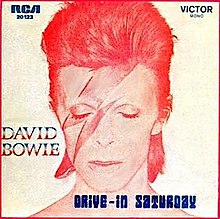Drive-In Saturday
| "Drive-In Saturday" | ||||
|---|---|---|---|---|
 |
||||
| Single by David Bowie | ||||
| from the album Aladdin Sane | ||||
| B-side | "Round and Round" | |||
| Released | 6 April 1973 | |||
| Format | 7" single | |||
| Recorded | RCA Studios, New York 9 December 1972 |
|||
| Genre | ||||
| Length |
4:29 (album version) 3:59 (German single edit) |
|||
| Label |
RCA Records 2352 |
|||
| Songwriter(s) | David Bowie | |||
| Producer(s) | Ken Scott, David Bowie | |||
| David Bowie singles chronology | ||||
|
||||
| Aladdin Sane track listing | ||||
|
||||
| Alternative cover | ||||
 |
||||
"Drive-In Saturday" is a song by David Bowie from his 1973 album Aladdin Sane. It was released as a single a week before the album and, like its predecessor "The Jean Genie", became a Top 3 UK hit.
Heavily influenced by 1950s doo-wop, "Drive-In Saturday" describes how the inhabitants of a post-apocalyptic world in the future (Bowie once said the year was 2033) have forgotten how to make love, and need to watch old porn films to see how it's done. The narrative has been cited as an example of Bowie's "futuristic nostalgia", where the story is told from the perspective of an inhabitant of the future looking back in time.
Its composition was inspired by strange lights amidst the barren landscape between Seattle, Washington, and Phoenix, Arizona, as seen from a train at night on Bowie's 1972 US tour. The music featured Bowie's synthesizer and saxophone, while the lyrics name-checked Mick Jagger ("When people stared in Jagger's eyes and scored"), the model Twiggy ("She'd sigh like Twig the wonder kid"), and Carl Jung ("Jung the foreman prayed at work"). The reference to Jung is significant according to artist Tanja Stark, and heralds the pivotal influence of Jungian depth psychology upon his career. She suggests the lyric "crashing out with sylvian" is a cryptic reference to the Sylvian fissure in the brain associated with visionary and hallucinatory experiences.
Bowie premiered the song live in November 1972—initially at either Pirate's World, Fort Lauderdale, Florida, or Celebrity Theatre, Phoenix—well before committing it to tape. He offered it for recording to Mott the Hoople but they turned it down, Bowie later saying that he didn't know why they refused it. However, in his 1972 tour narrative, Diary of a Rock 'n' Roll Star, Mott leader Ian Hunter appears utterly perplexed by the song's pop complexity when Bowie plays it to him, writing that it has "a hell of a chord rundown". Bowie claimed on VH1's Storytellers that his frustration with Mott the Hoople's rejection of the song led to his shaving of his eyebrows during the Ziggy Stardust tour, an alteration that remained evident in photographs as late as 1974.
...
Wikipedia
